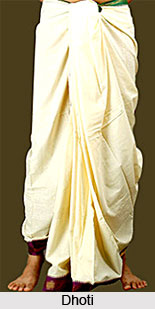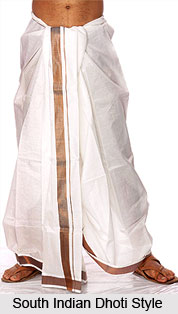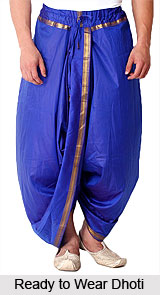 The word dhoti or dhotan originates from the Sanskrit word dhauta. It is one of the earliest known draped garments in India and continues to be worn even today. One of the reasons for the dhoti`s enduring popularity is its loose trouser-like form, which is convenient and extremely well-suited to the tropical Indian climate. The dhoti falls from the waist and partially or fully covers the legs by the pleating, folding and knotting of an unstitched length of cloth. The fabric for a dhoti is woven as a single rectangular piece and worn without any cutting or stitching. Its size varies from two to five meters in length and one to one and a half meters in width. It is usually white and made of cotton.
History of Dhoti
The word dhoti or dhotan originates from the Sanskrit word dhauta. It is one of the earliest known draped garments in India and continues to be worn even today. One of the reasons for the dhoti`s enduring popularity is its loose trouser-like form, which is convenient and extremely well-suited to the tropical Indian climate. The dhoti falls from the waist and partially or fully covers the legs by the pleating, folding and knotting of an unstitched length of cloth. The fabric for a dhoti is woven as a single rectangular piece and worn without any cutting or stitching. Its size varies from two to five meters in length and one to one and a half meters in width. It is usually white and made of cotton.
History of Dhoti
Dhotis were worn from the Vedic period onwards, if not earlier. Men and women of this period wore three garments, namely the loincloth or nivi, which had a long unwoven fringe, a garment or vasa and an over garment or adhivasa. There are numerous detailed representations from all the dynasties that reigned between the first and the 14th century A.D., indicating that the dhoti continued to be worn and that innovations were introduced, from time to time. For instance, the dhoti could be tied to the waist with a waist cloth that had a bow shaped knot with a patka hanging down the front. By the 10th century, the dhoti had been in existence for a fairly long period and several regional and local particularities had crept into its modes of draping.
Evolution of Dhoti
The garment dhoti continued to be worn throughout the medieval period. The Moorish traveller, Al-Biruni, who came to India in the eleventh century and left us a treasure trove of details of contemporary life and civilization of the time, made several observations on the dress of north-Indian men. During this time, the dhoti was held in place by a belt around the waist. The belt was embellished either with embroidery or some other form of ornamentation. It, sometimes, had an exquisite grasp that came to rest on the elaborately folded from pleats.
 In this period, the dhoti underwent incredible modifications in style, length of fabric and even its wearers. Yet, it continued to hold sway as the most popular of all the clothes available to Indian men. The dhoti is still draped at the waist, with elaborate pleating in the front and back. The differences in draping modes arise from social status, the occupation of the wearer and of course, individual taste. These numerous styles are developed through variations in the method of knotting and pleating, the length of the dhoti and the texture of the cloth. Men with sedentary occupation generally wear a long and extravagantly pleated dhoti. Those whose work involves more arduous physical labour wear a shorter style.
In this period, the dhoti underwent incredible modifications in style, length of fabric and even its wearers. Yet, it continued to hold sway as the most popular of all the clothes available to Indian men. The dhoti is still draped at the waist, with elaborate pleating in the front and back. The differences in draping modes arise from social status, the occupation of the wearer and of course, individual taste. These numerous styles are developed through variations in the method of knotting and pleating, the length of the dhoti and the texture of the cloth. Men with sedentary occupation generally wear a long and extravagantly pleated dhoti. Those whose work involves more arduous physical labour wear a shorter style.
Styles of wearing Dhoti
Some of the more prevalent styles of arranging the dhoti are into great use nowadays. It is fascinating to note how a piece of unstitched fabric can be draped in innumerable ways. The dhoti is always draped from the back, brought forward around the waist and secured around the abdomen.
Do lange Dhoti: It is the Ankle length one. In this style, first the dhoti is draped around the waist so that equal lengths of the dhoti arc left hanging at either side, and small double knots are made at the centre front to hold it on place. The whole length of the upper selvedge is given knife pleats. These are tucked in at the centre front and the front fold lace towards left. The width of the right pallav (fabric which is hanging loose) is passed between the legs to be tucked in at the centre back. The amount that is tucked is adjusted to the comfort of the wearer, thus leaving about half a metre cloth hanging. This piece of cloth is then brought over the side seam and tucked into the waist with a remainder of the cloth gently cascading down. The left selvedge is also pleated with the pleats tucked over the right pleats. Hereafter, it is draped in the same style as the right leg.
Tevata Dhoti: It is also called Mid-calf length dhoti. In this style of draping, the dhoti is first divided into two sections of unequal length, the right side being three times the length of the left, which is approximately only half a meter long. The left pallav is used to wrap the front part of the waist. Roughly 30 cms of each pallav of the dhoti are gathered together. The fabric of the left side is kept close to the skin and that of the right is crossed over the left and roughly tucked at centre front to secure the dhoti. The upper selvedge of the right side of the dhoti is gathered roughly from the centre front to form three pleats, which are tucked in at centre front. This leaves approximately a metre of cloth free. The right side pallav is then lifted and pulled tightly between the legs and tucked in at centre front. The second corner is then rolled and tucked inside.
Tilangi Dhoti: It is the ankle-length dhoti, where the left side of the dhoti is shorter than the right side by approximately two lengths. First, a small knot is given and then ends are twisted and tucked at the centre front. Then the upper selvedge of die left-hand side is held mid way at its length. It is then taken between the legs and tucked in firmly at centre back. The second corner is picked up and brought forward round the waist and tucked in almost near the centre front. The first corner is picked up and folded to form three triangular pleats. The narrower side of the triangular pleats are tucked 1 foot deep in at the centre front. The untucked upper selvedge is then drawn between the legs and tucked at centre back. This leaves the broader end of the triangular pleats still hanging. They are pulled tightly between the legs and tucked in at the midpoint at centre back. Finally, the remaining part of this fabric is brought to the front from the right and tucked near the centre front.
Dolangi Dhoti: Also called the Ankle-length style when the fabric is first divided into two lengths. As in the Tilangi style, left side of the dhoti is shorter than the right side by approximately two lengths. First, a small knot is given and the ends are twisted and tucked at the centre front. Knife pleats are made from corner A of the right pallav and are tucked at the centre front facing outwards. Left pallav is gathered at mid width, between the second and third corners, passed between legs and tucked at centre back. The remaining fabric is brought across the left hip and tucked near centre front. Similarly, the right upper selvedge is given knife pleats that arc turned outwards and tucked at centre front. These pleats are then picked up, brought tightly between the legs and tucked at their mid length at centre back. Remaining fabric is then tucked along the waist.
Marvari Dhoti: It is again a centralized one and double knots are tied at the centre front using 30 cms of the selvedge at both sides that are twisted inwards. The left upper selvedge is passed between the legs. Care is taken to ensure that the material does not ride up as the length of the dhoti is till the toes. From upper selvedge corner B, pleats are made first along the length and tucked at centre back and then the width is also pleated and tucked here. The pleats are then tucked at centre front. Short dhoti is centralised. The upper selvedge near centre front is gathered, twisted over each other, rolled down and tucked in. The right upper selvedge is taken between legs and tucked at its raid width at centre back. The remaining selvedge is pleated and tucked in at centre back. However, this still leaves some of the fabric hanging free around the hip region, which is roughly gathered and tucked in at centre back itself.
Left selvedge: This style is given knife pleats and tucked at centre front. Then third corner is lifted, and roughly pleated such that the length of the dhoti is raised till the knees. It is then taken across the right side of the waist to the back and brought forward to the left, passed under the folds and neatly tucked in the front.
These are some variations within the short dhotis. The process of tying is similar. First, a knot is tied at centre front. Then the remaining fabric is given either of the following treatments; both the pallav are passed between the legs and tucked in at the centre back. All the excess fabric is tucked in at the centre hack itself, so that it forms a bulging bundle of cloth, which can act like a cushion when one sits. The right side pallav of the dhoti is passed between the legs and tucked at centre back covering one leg. The left pallav is pleated and the pleated ends are tucked at centre front.
Dhoti is still known to be one of the most popular traditional wear amongst the Indian men. It is mostly worn during religious festivals or occasions.





















